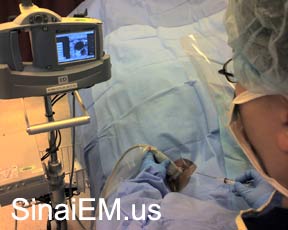 The literature for using ultrasound guidance in placing a central venous line is robust. There are many articles espousing the benefits of ultrasound guidance: reduced number of attempts, reduced complication rate, increased first pass success rate. So, it is indeed difficult to narrow down to a finger count of 3 articles. But if one were to spend time reading just 3 articles that define the topic, these 3 should be as good as any.
The literature for using ultrasound guidance in placing a central venous line is robust. There are many articles espousing the benefits of ultrasound guidance: reduced number of attempts, reduced complication rate, increased first pass success rate. So, it is indeed difficult to narrow down to a finger count of 3 articles. But if one were to spend time reading just 3 articles that define the topic, these 3 should be as good as any.
The first article comes from our colleagues in the UK, appearing in Emergency Medicine Journal in 2005. It is a well written review article that neatly summarizes the evidence for ultrasound guidance in central venous catheter placement. For those who need convincing to start using ultrasound, this is a good first article to read.
1)Â Atkinson, P., Boyle, A., Robinson, S., & Campbell-Hewson, G. (2005). Should ultrasound guidance be used for central venous catheterisation in the emergency department? Emerg Med J, 22(3), 158-64.
Are all central venous access options the same? Will ultrasound guidance have a positive effect on all central venous access? Different practitioners will have different experiences with internal jugular, subclavian and femoral vein approaches. Those who are intimately familiar with the subclavian approach usually swear by the landmark technique, due to the constant anatomy of the subclavian vein as it courses underneath the clavicle. In this case, ultrasound may not provide a clear benefit to trained practitioners using the landmark technique, but 2D imaging will certainly benefit novice performers. As it is, current evidence still favors ultrasound (2D) guidance in subclavian and femoral vein approaches.
2)Â Hind, D, et al. (2003). Ultrasonic locating devices for central venous cannulation: Meta-Analysis. BMJ, 327(7411), 361.
Dynamic and static guidance techniques for central venous cannulation have both been described. CMS (Centers for Medicare and Medicaid Serives) guidelines specify the use of dynamic guidance for procedure reimbursement, and many early studies questioned the benefit of the static guidance technique. Dynamic guidance implies real time sonographic imaging of the cannulation process, while static guidance uses ultrasound to first mark out the location of the vein before ‘blind’ cannulation. A dynamic approach may be more difficult to learn and master compared to the static approach, but both approaches with ultrasound are better than the traditional landmark technique. It may be worthwhile spending the time and effort to get acquainted with the dynamic method, as it is a clearly superior technique.
3)Â Milling, T. J, et al. (2005). Randomized, controlled clinical trial of point-of-care limited ultrasonography assistance of central venous cannulation: The third sonography outcomes assessment program (SOAP-3) trial. Critical Care Medicine, 33(8), 1764-9.
So that’s the top 3 for ultrasound guided central venous catheter insertion. While not quite a journal article, one should also get familiar with the 2001 report on patient safety, from the Agency for Healthcare Research and Quality. Just another piece of the armamentarium that one can use to justify, say, the purchase of a new ultrasound device.
